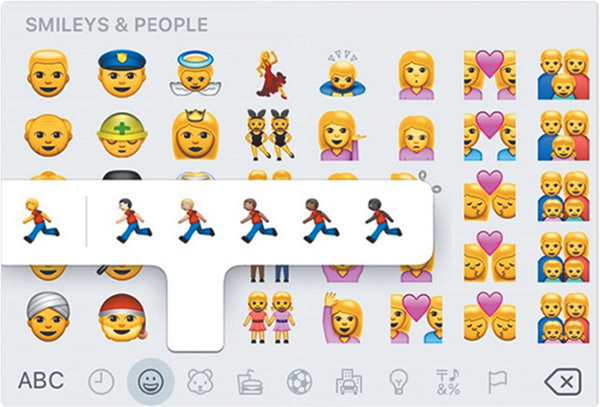Characteristics of Mediated Communication
Since mediated communication serves different functions, you have choices in the types of media you use to communicate with others. Imagine that you’ve just received a great job offer. Would you share the good news with your roommate in person or through a text message? In either format, your message is essentially the same: “I got the job!” But the characteristics of your communication—including how you interact with your roommate, the nonverbal cues exchanged, and how long your message endures—will differ depending on the media device or app you choose.
Synchronous versus Asynchronous Communication. When you talk with someone face-to-face, you’re engaged in synchronous communication: a back-and-forth exchange of messages that occurs in real time. Some media devices enable synchronous communication, including phone conversations, instant messages, and videoconferences. By contrast, in asynchronous communication, time lapses exist between messages. When you use e-mail, send a text message, or post to a social media site, a delay occurs before a response arrives or you may get no response at all.
Synchronous communication is best used when you’re communicating difficult or complicated messages. For example, you may want to use the phone or video chat to tell your family that you won’t be coming home for the holidays as planned. If you text them with the news, they may think you’re insensitive or incompetent (“What kind of daughter cancels holiday plans through a text?”). However, synchronous communication requires all the communicators to be available at the same time. That’s not always possible, especially when people live in different time zones or have conflicting work or life schedules. In these situations, asynchronous communication may be your only choice for sending and receiving messages. It is also appropriate for nonurgent, quick, and simple messages, such as letting a friend know you’re running a few minutes late for a lunch date.
Restriction of Nonverbal Information. Communicating face-to-face with others provides immediate access to nonverbal cues, such as facial expressions and tone of voice, which help you understand other people’s thoughts and feelings. When your roommate responds with a smile and a high-five after you tell her you got a new job, she clearly feels happy for you. As Chapter 6 explains, nonverbal behaviors are undeniably an important part of your communication with others.
In mediated communication—especially those forms that involve text only—you get little or no nonverbal information. According to the cues-filtered-out model, in this type of communication, many of the cues vital for making sense of messages are not available; they are “filtered out” (Culnan & Markus, 1987). This makes mediated communication more difficult to understand than face-to-face communication. If you’re e-mailing or texting with someone, it’s almost impossible to tell if he or she is being sarcastic or sincere. In one study, 27 percent of respondents agreed that e-mail is likely to result in miscommunication of the senders’ intended meaning, and almost 54 percent agreed that it’s relatively easy to misinterpret an e-mail message (Rainey, 2000). To help minimize such confusion, communicators use acronyms (LOL, SMH), emoticons, or emoji to convey their intent more clearly. But even these symbols are a poor substitute for the nonverbal cues available when communicating face-to-face.
The fact that nonverbal information is restricted during most mediated communication doesn’t necessarily mean that the interaction is less important or personal. According to social information processing theory (Walther, 1992), people communicating through social media compensate for the lack of nonverbal cues by taking more care when choosing their words. The result is that mediated communication, though “cue filtered,” can be just as personal as face-to-face interaction (Walther & Parks, 2002).
To help neutralize the cues-filtered-out model, a common practice is to use emoticons or emoji (like the ones shown here) to provide some nonverbal cues about the message’s intent. In what types of scenarios do you use such images to clarify the meaning of your text messages?
Message Life Span. A basic principle of communication is that there are no “take-backs” or do-overs. Everything you say becomes part of the permanent record of your relationship with others. So when you snap at your parents or insert a tasteless joke into a speech, you can’t turn back time and erase your error.
This is especially true in mediated communication. Every time you send a digital message (text, e-mail, tweet, video, or post), it stays in your account and in the accounts of those who received it. It also stays in the servers of companies hosting the accounts. Deleting a text, an e-mail, a post, or the entire account doesn’t make the information go away. Anyone with the right access can find it. Even apps that promote disappearing messages or pictures (like Snapchat) can be easily saved with a little know-how.
Digital messages thus have a long life span and are easily searchable, retrievable, and replicable (boyd, 2007). Why does this matter? One reason is because many employers check job applicants’ social media profiles to get a sense of what the applicant is really like. Some even ask for applicants’ passwords to closely examine their accounts (Garber, 2012). Although that is an extreme (and possibly illegal) case, it is commonplace for employers to Google potential new hires. If you Google your own name, what comes up? Search engines can easily find your digital trail and deliver it to anyone who wants it. Be mindful when sending text messages and e-mails or posting online, because you’re creating an enduring record of your communication that is easy to find and to share.
